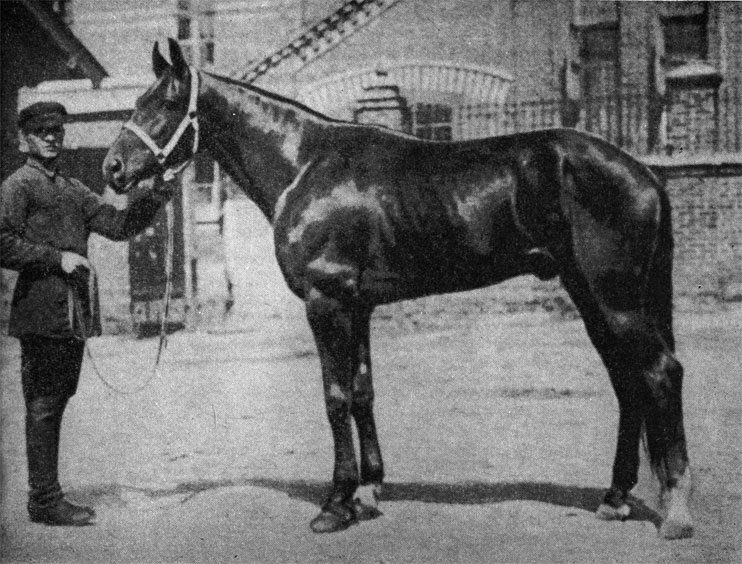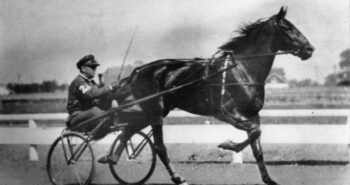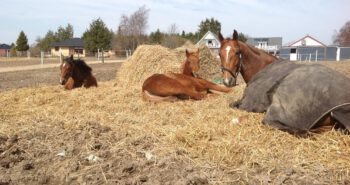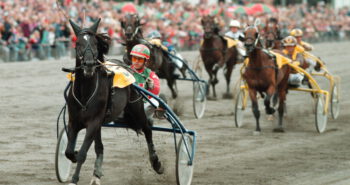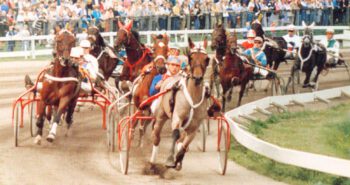The first World War took an especially heavy toll on Ukraine as well as the Russian Empire as almost all horses perished. One US import survived, however, and after the war gave birth to one of a good trotters who turned out to be one of the best stallions ever seen in Eastern Europe. While he was very good on the tracks, as a stallion Gildeets dominated Soviet trotting for many years.
Note on spelling: Because of the challenges involved in translating between the Cyrillic and the Latin alphabets other spellings of the name exist.
In the spring of 1919 Europe was trying to recover from World War I. In the Russian Empire, things were bad. Even before WWI the empire had numerous internal problems which were exasperated by the war. This culminated with the revolutions in 1917 and civil war going until 1923. Food shortages were everywhere, and many horses were slaughtered. In 1918 Lenin’s government nationalized industry, including farms. Horses were worked very hard, and many trotters succumbed to this. Numbers show a 95 % decline in thoroughbred stock in the country for the seven-year-period starting in 1914. It seems to have been better for the Orlovs and standardbred trotters, but many were lost in this period, too. One who, though barely, did survive the WWI was Gay Bingen, an American import born 1903. In 1919 his son Gildeets was born.
Gildeets had a heavily US-influenced pedigree. His damsire was the US-born Passe Rose, a 2:14.2 (1.23,5) trotting son of Patron, whose paternal line traced back to Mambrino Chief. There is still plenty of Hambletonian in this pedigree with his sons Strathmore as damsire and Volunteer as damdamsire. Gildeets was bred by the Natalevskom farm roughly 30 kilometers west of Kharkov in Ukraine and acquired by the Dubrovsky farm, roughly midway between Kyiv and Kharkov in the Poltava region in Ukraine.
Winning the Derby
It was not immediately apparent that Gildeets was a future star, rather the opposite. In their own small biography on the horse, the Dubrovsky farm writes “he came to the Dubrovsky stud farm after testing at the Kharkov Hippodrome as a two-year-old and looked like a living skeleton.” The 1921-1923 famine in Ukraine was a humanitarian disaster and started with severe drought and starvation in the summer of 1921, both in Russia and Ukraine. According to Wikipedia, “Vladimir Lenin and the Moscow government ordered to move trains full of grain from Ukraine to the Volga region, Moscow and Petrograd to combat starvation there.” It stands to reason, then, that Gildeets as a youngster may have suffered like so many other animals in the area. At the Dubrovsky farm he did, however, clearly receive excellent care and still flourished.
The 1923 Russian Derby, for four-year-olds, was an easy prey for Gildeets, who arrived at the big race undefeated. In the race he wasted no time mopping the floor with the opposition as he burst to the lead immediately. On the last lap Gildeets left his competitors, winning easily in 2:15 (1.23,9), while Utopia was second in 2:17 3/10 (1.25,3). The winning time was a Derby-record that would stand for several years, even though it had been set on a wet and demanding track. The following year Gildeets set his career mark when he won in 2:11 (1.21,4) at the Kharkov track. He finished his career at 10 by winning the “Prize in commemoration of the 12th anniversary of the October Revolution” on November 8, 1929, in Kharkov.
Becoming a champion stallion
When Gildeets rounded off his career with a win, he had already stood stud for four years. The Gay Bingen-son, described as a really nice horse to work with, was listed as standing stud from 1925 to 1941, though there is one single foal born 1943 according to the databases. But sometimes one is all you need. It turned out that way in Gildeet’s case since his lone 1943 foal, Gagach, won the Soviet Derby in 1947. That was 14 years after the first Gildeets-winner in that race: the legendary mare Gilda in 1933. Then followed Bayaderka in 1938, Gorta in 1940, Djilda in 1941 and Zdignyy in 1944.
To produce six winners of the Soviet Derby was more than any other stallion at the time, and would later only be surpassed by the magnificent Noble Victory-son Reprise. However, his achievements at stud goes far beyond the six Derby-winners. Gilda was a 2:05 (1.17,7) trotter at 4. Her record time equaled that of Gorodnya, another four-year-old daughter of Gildeets back in 1933. Three years later, another four-year-old daughter of Gildeets, La Bayadere, lowered this record to 2:04 3/5 (1.17,4). Then in 1940, Gorta lowered this to 2:03 1/10 (1.16,5). This was one of 11 records Gorta broke. In total Gildeets produced 14 trotters who trotted below 2:10 (1.20,8) and 4 below 2:05 (1.17,7), very solid also when compared to US stallions at that time.
Interestingly enough, most of his top get were produced by inbreeding to Gay Bingen. The farm managers appear to have been targeting 2×3, 3×3 and 2×4 inbreeding on Gay Bingen in a determined and highly systematic fashion. The three Derby-winners Gilda, Gorta and Zdignyy, note that the first and the last are full siblings, were all bred in a 2×3 inbreeding pattern on Gay Bingen as their dams were daughters of Gambler, another son of Gay Bingen.
When Gildeets had passed on, his sons and daughters continued in splendid fashion and the Gildeets sireline was for many years the strongest in the Soviet Union. In 1951 Arzamas won the Sovet Derby. He was sired by Zdignyy, one of Gildeet’s six Derby-winners, and was in fact 2×3 inbred on Gildeets. In 1954 Gonny and Geliotrop both finished first in the Soviet Derby. Both were by Gildeets-sons inbred on Gay Bingen, and the stallion was obviously a dominant factor in Soviet trotting for many years.
It’s unclear from historical records how long Gildeets lived and if World War II affected this.
Gildeets
Bay colt born close to Kharkov, Ukraine in 1919. Appears to have died in the Soviet Union in 1942 or 1943.
Gay Bingen – Pobeda (Passe Rose)
2:11 (1.21,4)
Breeder: Natalevskom farm
Owners: Natalevskom farm, Dubrovsky farm
Trainer: Mikhail Stasenko
Drivers: Mikhail Stasenko, A.V. Konstantinov and others
Groom: –

